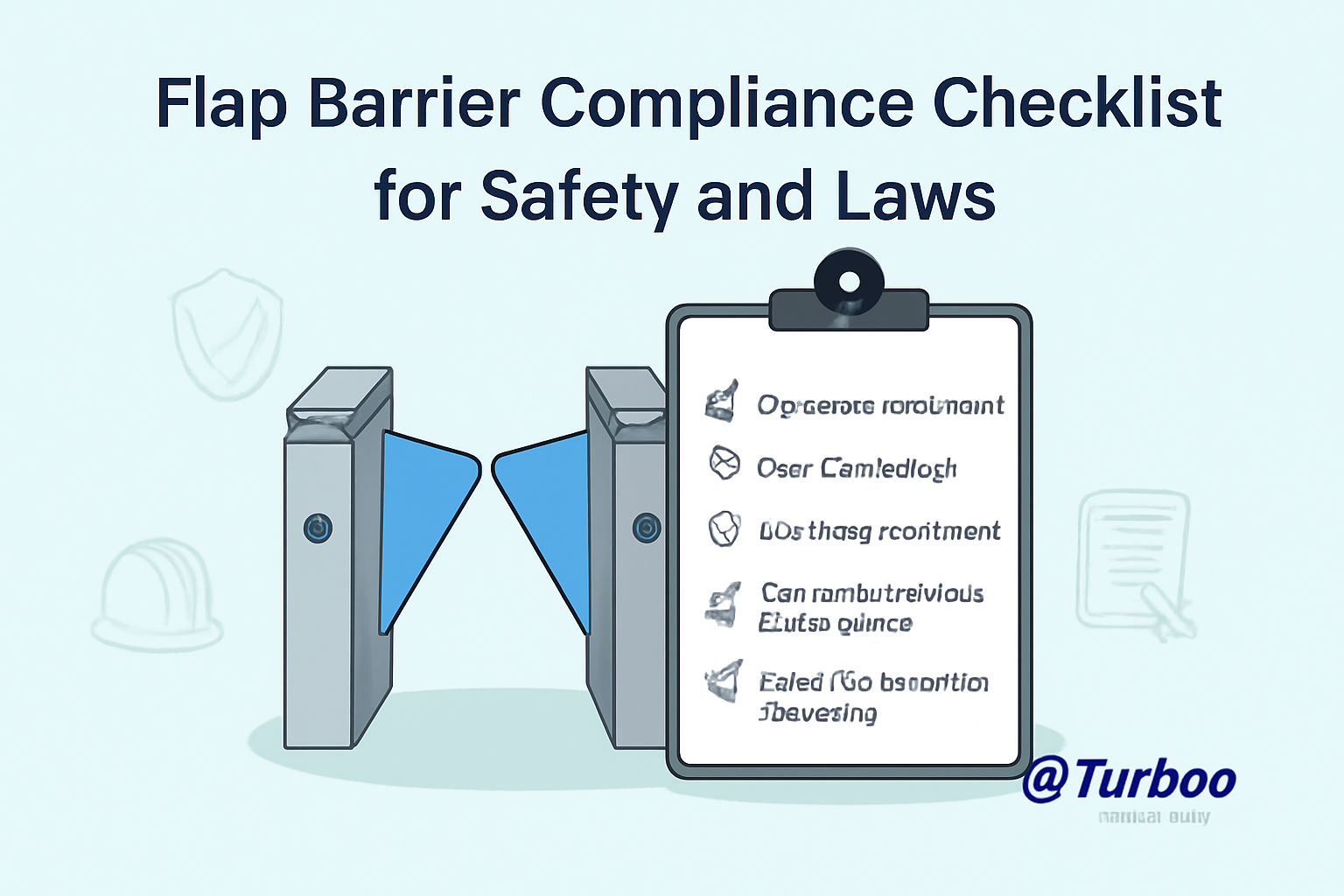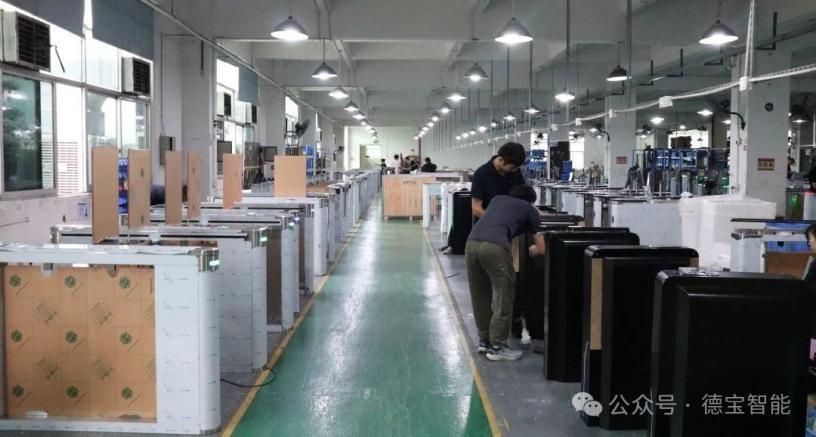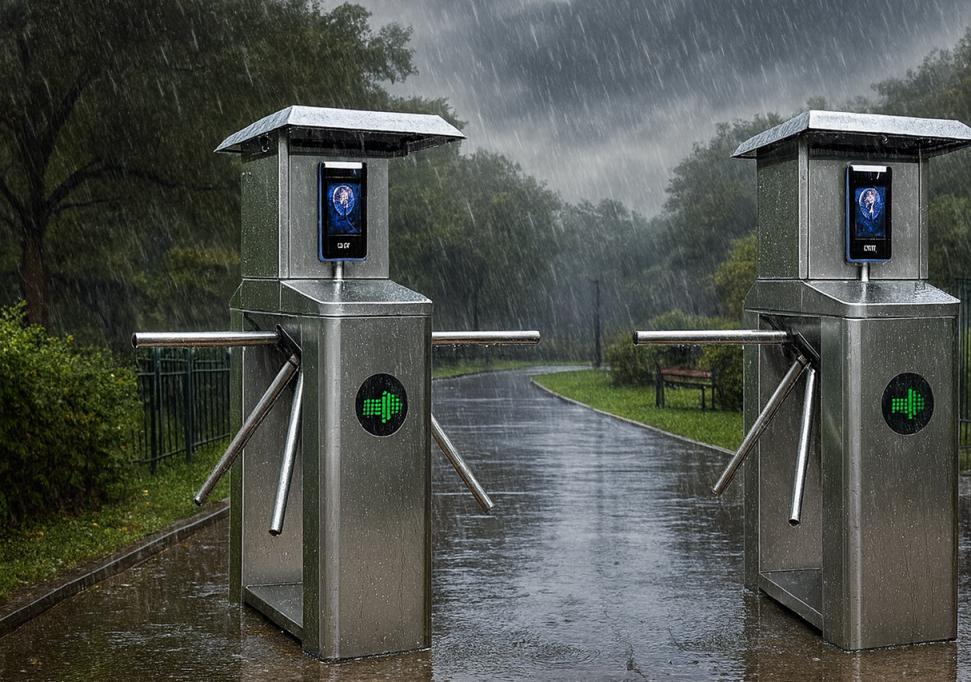Flap Barrier Compliance Checklist for Safety and Laws


Compliance matters. It prevents fines. It protects people. Flap barrier compliance is non-negotiable. Facility managers and safety officers must get it right. This article delivers a clear, actionable guide. It uses a comprehensive regulatory checklist. You will learn every essential step. You will gain legal peace of mind and bolster safety compliance. Read on to secure your site and meet all legal standards.
What Is Flap Barrier Compliance
Flap barrier compliance blends safety compliance with legal standards. It ensures that barriers meet both operational safety and regulatory requirements. In safety terms, it means the barrier will not harm users. It will open reliably in emergencies. It will resist mechanical failure. It will comply with fire egress rules to avoid entrapment. In legal contexts, compliance means the product holds valid certifications. It follows codes set by authorities. It aligns with local building regulations. It satisfies occupational safety laws. The dual focus on safety laws and legal standards makes flap barrier compliance critical.
Definition in Safety Context
Safety context defines how flap barriers protect people. A compliant flap barrier uses sensors to detect obstruction. It prevents the barrier from closing on a user. It opens automatically upon power loss or fire alarm activation. It integrates with fire detection systems to allow emergency egress. It must pass impact and durability tests under defined loads. These elements form the core of safety compliance. They reduce the risk of injury. They ensure uninterrupted evacuation routes. They guarantee adherence to fire safety codes set by local authorities and organizations such as the National Fire Protection Association.
Definition in Legal Context
Legal context frames flap barrier compliance within laws and regulations. It demands valid certifications from accredited bodies. It enforces conformity to occupational safety regulations like legal standards in the U.S. or similar frameworks abroad. It requires documentation proving that the barrier meets performance criteria. It may involve periodic recertification or renewal of approvals. Legal context also covers liability insurance requirements. Non-compliance can lead to fines, shutdown orders, or lawsuits. A robust regulatory checklist guards against these risks by ensuring all legal boxes are checked.
Certification Standards for Flap Barriers
Certification standards validate product safety claims. They confirm that a flap barrier complies with both international and local mandates. These standards often emerge from bodies such as ISO or IEC. They set the benchmark for design, testing, and performance. A trustable certification indicates that the product underwent rigorous testing in accredited labs. It shows that the manufacturer adheres to documented quality processes.
International Certification Standards
International certification standards originate from organizations such as the International Organization for Standardization. The ISO sets out various standards relevant to flap barriers. These include mechanical safety, electromagnetic compatibility, and fire resistance protocols. A compliant flap barrier must follow the guidelines in ISO 13849 for safety-related control systems. It must meet requirements in ISO 13709 for reliability. When a product bears an ISO mark, it signals global acceptance. It simplifies cross-border installations by aligning with the compliance guide for equipment safety.
Local and Regional Certification Requirements
Local authorities often add layers of certification standards. They adapt or augment international norms to reflect regional priorities. A city fire marshal can mandate additional fire safety tests on flap barriers. A national standards body may require extra inspections under electrical codes. For example, European installations need CE marking to prove compliance with the EU Machinery Directive. In the U.S., UL listing may be mandatory. Facility managers must map these regulatory requirements early in the project. Early mapping avoids delays and costly retrofits. It also ensures that flap barrier compliance covers every geographic jurisdiction.
Fire Safety Rules and Regulations
Fire safety rules protect lives and property. They mandate unobstructed egress during emergencies. Flap barrier compliance must integrate with fire alarm systems. It must default to an open position on alarm. It must withstand high temperatures for a defined time. Fire codes vary by region, but the core principles remain. They center on safe evacuation and barrier reliability under fire conditions.
Applicable Fire Safety Codes
Authorities publish fire safety codes to govern building safety. These codes define barrier behavior in fire. They specify materials that resist flame spread. They require certain fail-safe states upon alarm. They outline test procedures for heat resistance. Fire doors and shutters follow similar rules; flap barriers must align with them. Adhering to fire safety codes ensures that safety officers meet the legal duty of care. It prevents operational shutdowns due to non-compliance. It also helps secure insurance coverage.
Emergency Egress Considerations
Emergency egress rules ensure people can exit swiftly. Flap barriers must not delay evacuation. They must detect crowd pressure and unlock immediately on alarm. They should have clear signage and lighting. They must allow two-way flow if needed. They should avoid false activations that might jam the gate. A robust regulatory checklist will verify each egress criterion. It will test barrier response times under simulated fire conditions. It will document results for inspectors and auditors.
Regional Regulatory Requirements
Regulations differ by region and facility type. A government building faces stricter oversight than a private office. An airport has unique aviation authority rules. A hospital must follow health care codes. Flap barrier compliance must account for all these variations. Failure to do so can trigger site closure or legal action.
Regulations by Region
Each region enforces its own building and safety codes. In North America, the National Fire Protection Association and OSHA set broad mandates. In Europe, the EN standards and EU directives apply. In Asia, national bodies adapt international norms. A compliance team must research regional codes early. It must compare them with the base product specifications. This ensures a seamless fit between the flap barrier and local rulebook. It reduces the risk of last-minute modifications.
Facility-Specific Regulatory Requirements
Different facilities have bespoke requirements. An airport needs FAA approval for passenger flow barriers. A data center may require additional security integrations. A hospital wing demands antimicrobial materials and fire-safe operation. A stadium mandates high throughput and emergency crowd evacuation scenarios. Each facility type adds unique layers to the regulatory checklist. Compliance teams must engage end-users, maintenance staff, and local inspectors. They must translate these needs into technical and documentary proof.
Installation Site Assessment
A thorough installation site assessment is the foundation of any successful compliance program. Safety compliance begins long before the flap barrier arrives on-site. It starts with a detailed evaluation of the physical environment. It requires walking the exact pathway where the barrier will stand. It demands measuring clearances. It demands noting nearby obstructions. It warrants verifying floor strength and leveling. It also involves consulting electrical and fire suppression plans. A solid site assessment prevents surprises during installation and commissioning.
Installation site assessment hinges on two key activities. First, conducting formal risk assessment procedures to identify potential hazards. Second, executing comprehensive site inspection protocols to verify that the location meets all prerequisites for a compliant installation.
Risk Assessment Procedures
Risk assessment procedures are systematic. They identify hazards that could compromise safety compliance. A risk assessment begins with a site survey. Safety officers note existing barriers, walls, and structural elements. They record pedestrian flow patterns. They quantify peak and off-peak traffic loads. They consider adjacent machinery or equipment that could trigger false activations. Next, they analyze historical incident data from similar sites. They study near-miss reports to pinpoint hidden dangers.
This analytical approach feeds into a formal risk matrix. Each hazard is scored by likelihood and severity. High-risk items demand immediate mitigation. Medium-risk items require documented control measures. Low-risk items are monitored. The final risk assessment report forms part of the regulatory checklist. It ensures that flap barrier compliance addresses both common and site-specific hazards before installation.
Site Inspection Protocols
Site inspection protocols ensure the location meets technical and regulatory requirements. Inspectors verify dimensions against barrier specifications. They confirm that electrical supply meets voltage and current ratings. They check that backup power sources are available if required by safety laws. They ensure the flooring can support barrier weight and dynamic loads. They test ambient temperature and humidity to confirm product tolerance. They inspect nearby fire-safety equipment to verify integration pathways.
They confirm clear sightlines for users approaching the barrier. They verify that no permanent obstructions block emergency egress routes. All findings are logged in an inspection form. This form is retained as evidence of compliance. It becomes part of the project’s documentation and helps expedite regulatory approvals.
Technical Specifications and Maintenance
Technical specifications define the mechanical and electrical parameters of a flap barrier. They lay out exact performance criteria that underpin safety compliance. They detail motor torque, opening and closing speeds, sensor sensitivity, and power failure behavior. They specify materials for corrosion resistance and fire retardance. They set tolerances for manufacturing deviations. They reference industry benchmarks and certification standards. These specifications are the backbone of any regulatory checklist. They ensure that the barrier operates within designed safety margins and meets all certification standards.
Routine maintenance is equally vital. Even a fully certified barrier can drift out of compliance without proper upkeep. A rigorous maintenance schedule preserves safety compliance over the barrier’s entire lifecycle. It prevents wear-and-tear failures. It ensures sensors and electronics remain calibrated. It secures continuous adherence to regulatory requirements.
Mechanical and Electrical Specifications
Mechanical specifications cover the flap barrier’s moving parts. They define motor ratings, drive mechanisms, and bearing tolerances. They dictate flap arm materials—often tempered glass or stainless steel—for optimal strength and transparency. They set maximum force exertion limits to protect users. They require anti-trap sensors to detect presence and immediately reverse motion. Electrical specifications detail power supply requirements. They define acceptable voltage ranges, frequency tolerance, and surge protection levels. They specify internal wiring standards, such as gauge size and insulation type.
They mandate compliance with electromagnetic compatibility regulations to avoid interference with nearby equipment. They require a fail-safe default mode—often automatically unlocked on power loss. Together, these precise specifications guarantee that the barrier performs safely under all normal and emergency conditions.
Routine Maintenance Schedules
A routine maintenance schedule is a proactive tool for sustained compliance. It establishes periodic inspections of mechanical components. Technicians check for loose fasteners, lubrication levels, and wear on moving parts. They test the sensor arrays and safety interlocks for proper function. They inspect wiring connections for signs of corrosion or damage.
They update firmware and calibrate control modules to the latest compliance-driven settings. They test emergency release mechanisms and backup power systems. Each maintenance activity is logged in a record book or digital system. This log serves as proof of ongoing safety compliance. It supports internal and external audits. It helps uncover emerging issues before they evolve into compliance failures or safety hazards.
Documentation and Record Keeping
Documentation and record keeping are often overlooked. Yet they form a critical pillar of any compliance program. Without meticulous records, it is impossible to prove adherence to safety laws and regulatory requirements. Documentation provides objective evidence of due diligence. It covers certification files, inspection reports, maintenance logs, and incident reports. It ensures transparency for both internal stakeholders and external auditors.
Comprehensive record keeping enables quick resolution of compliance queries. It aids in root cause analysis when incidents occur. It supports continuous improvement by revealing trends in equipment performance. It also streamlines renewal processes for certifications and permits.
Certification and Inspection Logs
Certification logs document every approval the flap barrier has received. They include international certifications, such as ISO marks, and local approvals like CE or UL listings. Each certificate is accompanied by the issue date, expiry date, and scope of compliance. Inspection logs capture the details of every site inspection and maintenance check. They include inspector names, dates, findings, and corrective actions taken. They may incorporate photographs or test results. These logs are organized chronologically. They are backed up digitally and stored securely. They ensure that any auditor can instantly verify that the flap barrier has remained in compliance since installation.
Incident and Maintenance Reports
Incident reports record any event that disrupted normal barrier operation. They cover sensor failures, false activations, emergency releases, or user entrapment events. Each incident is documented with exact time stamps, descriptions, and root-cause analysis. Maintenance reports capture all routine and corrective actions. They specify parts replaced, calibrations performed, and updates applied. Each entry is signed off by the technician and reviewed by a compliance officer. This dual-layer sign-off process ensures both operational and managerial oversight. Together, incident and maintenance reports provide a continuous chain of evidence. They demonstrate adherence to safety compliance and help refine future maintenance schedules.
Training and Operational Procedures
Properly trained staff are the human element of safety compliance. No amount of technical specification can guarantee safety without competent operators. Training programs must cover both routine operation and emergency protocols. They must emphasize regulatory requirements and legal standards. Training reinforces the correct use of the flap barrier. It prevents misuse that could void certifications or breach safety laws.
Operational procedures codify the way staff interact with the barrier. They establish clear guidelines for daily checks, alarm responses, and emergency overrides. They ensure that every action aligns with the compliance checklist.
Staff Training Programs
A robust training program starts with a needs assessment. Compliance teams identify all user roles—security guards, maintenance technicians, facility managers—and determine required competencies. They develop curricula covering device operation, safety compliance principles, and regulatory requirements. They include hands-on sessions to practice emergency egress procedures and simulated power-failure drills. They test trainees with written assessments and practical exams. Successful candidates receive signed certificates that become part of the staff member’s training record. Refresher courses are conducted periodically to reinforce “safety compliance” culture and ensure new regulatory requirements are fully integrated into daily practice.
Emergency Operation Protocols
Emergency operation protocols define step-by-step actions during critical events. They cover fire alarms, power failures, medical emergencies, and security breaches. They specify who authorizes manual overrides. They describe how to activate emergency egress mode. They detail post-incident procedures, such as logging the event and inspecting for damage. They ensure seamless coordination among security, maintenance, and evacuation teams. By codifying these procedures, compliance teams guarantee that every emergency action complies with the regulatory checklist and meets all “legal standards” without hesitation.
Auditing and Compliance Checks
Regular auditing is essential to maintain regulatory compliance over time. An audit is a systematic review of all processes, documents, and equipment. It verifies that flap barrier compliance is not a one-time effort but an ongoing commitment. Audits identify deviations from the compliance checklist. They provide recommendations for corrective actions. They help measure the effectiveness of training, maintenance, and documentation systems.
External inspections by authorities or third-party auditors validate internal compliance efforts. They offer an objective assessment. They may uncover blind spots that internal teams overlooked. Regular audits and inspections keep the facility prepared for any unexpected regulatory review.
Internal Audit Processes
Internal audits are conducted by the facility’s own compliance team. They follow a predefined audit schedule. They review certification documents, inspection logs, and incident reports. They perform physical spot checks on the barrier’s operation. They interview staff to confirm procedural knowledge. They compile an audit report highlighting strengths and areas for improvement. They assign action items with clear deadlines and responsible parties. Following the audit, the compliance team verifies that all corrective actions are completed and documents the closure.
External Inspection Requirements
External inspections are performed by local authorities or accredited inspection bodies. They may occur annually or after major system modifications. Inspectors review all documentation. They observe barrier operation under test conditions. They may conduct fire simulation tests or power-failure drills. Successful external inspections result in formal approval letters or renewed permits. Any non-conformance triggers a follow-up inspection or fines. Staying audit-ready ensures uninterrupted operation and continuous compliance with all “safety laws” and “regulatory requirements.
Common Compliance Pitfalls
Many projects stumble over hidden pitfalls that undermine flap barrier compliance. One frequent issue is incomplete mapping of regional regulatory requirements. Teams may assume that a barrier compliant with international standards automatically meets local codes. They skip detailed reviews of municipal or industry-specific mandates. This oversight leads to retrofits and delays. Another pitfall involves lax documentation. Some facility managers rely on verbal confirmations of maintenance or training. They fail to record inspection logs or incident reports. When auditors arrive, they find gaps in the compliance trail. This can trigger non-conformance notices or penalties.
Sensor calibration errors are also common. Safety compliance depends on precise sensor sensitivity. If sensors drift over time, the barrier may fail to detect obstructions. This creates entrapment risks and voids certifications. Yet many teams do not schedule regular calibration checks. They treat sensor setup as a one-time task. Lack of clear operational procedures compounds this problem. Staff may override safety interlocks without logging the event. They may disable emergency release features during maintenance, forgetting to re-enable them. These actions breach both safety laws and legal standards and expose the organization to liability.
Consequences of Non-Compliance
Ignoring flap barrier compliance carries serious safety and liability risks. From a safety standpoint, non-compliant barriers can trap or injure users. They may jam during evacuation, blocking emergency egress. They can fail to open on fire alarm activation. These failures can result in injuries, property damage, or worse. They damage an organization’s reputation and erode trust among employees and visitors. In the aftermath of an incident, investigators scrutinize compliance records. Any deviation from the regulatory checklist can become evidence of negligence.
From a legal perspective, non-compliance invites fines and operational shutdowns. Authorities can suspend occupancy permits until the barrier meets all regulatory requirements. They may issue stop-work orders during installation or commissioning. Insurance carriers often deny claims if the barrier lacked valid certifications at the time of a claim. Lawsuits alleging personal injury become costlier when it is shown that safety compliance was ignored. Companies face cumulative fines under occupational safety statutes and building codes. They may incur legal defense costs and settlements. In extreme cases, responsible managers can face personal liability under certain jurisdictions. Thus, the financial and human costs of non-compliance far exceed the investments required for proper flap barrier compliance.
Best Practices for Ensuring Compliance
Proactive compliance strategies minimize risks and streamline installations. Begin by assembling a multidisciplinary compliance team. Include safety officers, legal advisors, facility engineers, and operations staff. This team conducts a comprehensive gap analysis between existing processes and the full regulatory checklist. It maps out all certifications, fire safety rules, and local regulations. It assigns clear ownership for each compliance area. This approach embeds “safety compliance” into every project phase, from design to decommissioning.
Continuous improvement processes further reinforce compliance. After initial installation and auditing, the team implements routine reviews. These reviews assess audit findings, incident reports, and maintenance logs. They measure key performance indicators, such as response times for emergency egress activations and sensor calibration accuracy. They update standard operating procedures to incorporate lessons learned. They adjust training curricula to cover any newly identified compliance gaps. By making compliance an iterative cycle, organizations maintain high levels of regulatory readiness and adapt swiftly to changes in safety laws or certification standards.
Technological Advances in Compliance Monitoring
Modern technologies offer powerful tools to support flap barrier compliance. Internet of Things (IoT) and sensor integration enable real-time monitoring of barrier performance. Smart sensors can continuously track opening and closing speeds, motor currents, and obstruction events. They detect anomalies that signal drift in “regulatory requirements” and trigger alerts before a non-compliance event occurs. Cloud-based dashboards aggregate data from multiple barriers across facilities, providing compliance officers with a centralized view of system health.
Software and reporting tools further streamline record keeping and auditing. Mobile applications allow technicians to log maintenance tasks instantly, attaching photos or sensor data. Automated compliance software can generate inspection schedules, remind teams of upcoming certification renewals, and compile audit-ready reports with minimal manual effort. These digital solutions enhance accuracy, reduce paperwork, and ensure that all compliance actions are timestamped and traceable. By leveraging technology, organizations can transform flap barrier compliance from a reactive chore into a proactive, data-driven practice.
Cost-Benefit Analysis of Compliance
Investing in flap barrier compliance yields measurable returns. The upfront costs include certified equipment, installation site assessments, and staff training. There are also expenses for maintenance schedules and documentation systems. However, these investments mitigate far greater risks. Avoided fines, legal fees, and shutdown costs can reach six figures for a single incident. Preventing injuries preserves workforce productivity and morale. Maintaining uninterrupted operation safeguards revenue streams, especially in high-traffic facilities like airports or stadiums.
When evaluating return on investment considerations, factor in insurance premium reductions. Many carriers offer lower rates to organizations with robust compliance programs. They recognize reduced risk profiles when equipment meets “certification standards” and safety laws. Additionally, a reputation for exemplary regulatory compliance can become a market differentiator. It attracts clients and tenants who value high safety and legal standards. Over a facility’s lifecycle, the cost-benefit analysis strongly favors comprehensive, ongoing flap barrier compliance.
Conclusion
Flap barrier compliance is essential for safety and legal peace of mind. It demands a holistic approach that spans certifications, fire safety rules, regional regulations, site assessments, technical specifications, and rigorous documentation. It requires trained staff, regular audits, and leveraging modern compliance technologies. Ignoring compliance can lead to serious injuries, legal penalties, and financial losses. By implementing best practices and continuous improvement processes, organizations can maintain high levels of safety compliance. They can protect people, property, and reputation while enjoying cost savings and operational continuity.












